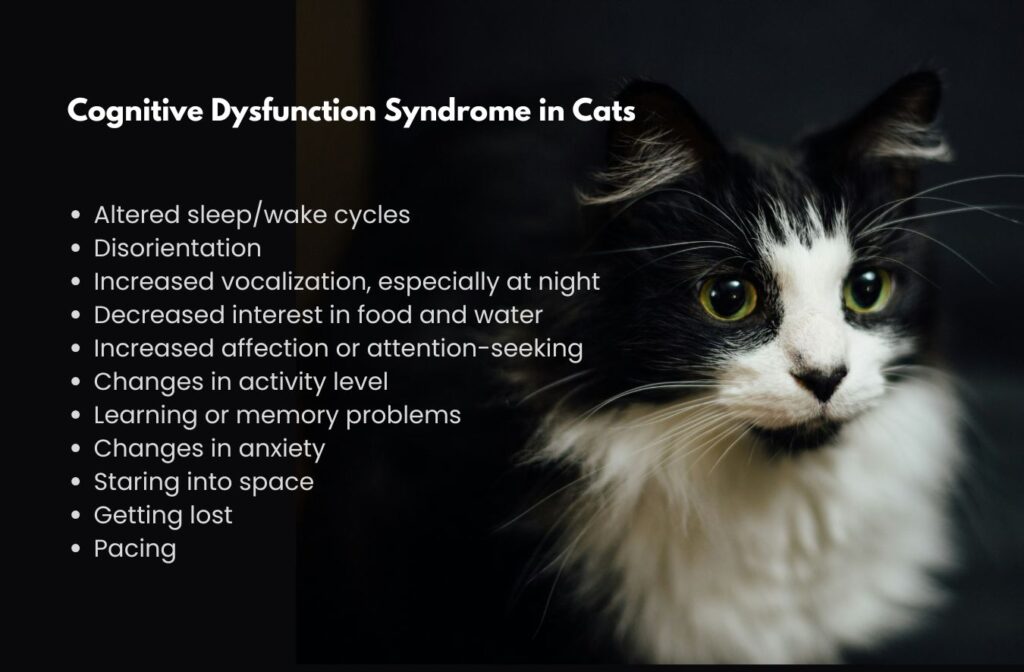House cats live an average of 14 years, and it’s not uncommon for a cat to live more than 20 years. Older cats often develop cognitive decline resulting in dementia. It’s called “cognitive dysfunction syndrome” or CDS. This condition is similar in many ways to Alzheimer’s disease, including amyloid beta and tau protein accumulation. Some believe that environmental stressors from life as a house cat contribute to cognitive decline.
Characteristics of cognitive dysfunction syndrome in cats
Many changes occur in our pets as they age. CDS is characterized by a decline in cognitive abilities with age. Almost 30% of cats display cognitive symptoms at 11-14 years. Some of the signs of CDS in cats are:
- Excessive vocalizations, especially at night
- Increased affection or attention-seeking
- Changes in sleep-wake cycles
- Soiling in the house
- Disorientation
- Changes in activity
- Changes in anxiety level
- Learning or memory problems
Is feline cognitive dysfunction syndrome like “kitty Alzheimer’s disease”?
CDS in cats has a very similar trajectory to Alzheimer’s disease in humans. Alzheimer’s is characterized by two conditions within the brain: amyloid beta deposits and tau tangles. Abnormal levels of amyloid beta protein clump together outside nerve cells (or neurons) to form plaques that disrupt cell function. Neurofibrillary tangles are abnormal accumulations of tau proteins that collect inside neurons. Normally, these proteins help support the neurons, but in Alzheimer’s disease the tau proteins stick together inside the cells, blocking communication signals.
Elderly cats develop both amyloid and tau pathologies, leading some researchers to suggest cats as a model for Alzheimer’s disease. Research by scientists at the University of Edinburgh found that the brains of older cats have large amyloid deposits outside of cells that may begin to appear as early as four years of age. “Pre-tangles” of tau also occur within nerve cells of older cats. The authors noted that “…the progression of these pathologies in terms of their brain location are similar to those seen in humans with AD (Alzheimer’s disease).”
Stress may be causing neurological issues in house cats
Unlike the long history of domestication in dogs reaching back 30,000 years or more, the domestication of cats happened about 10,000 years ago, and cats became house pets only relatively recently. Their genetic make-up is nearly identical to the likely ancestor of domestic cats.
An intriguing 2024 publication in Frontiers in Neurology argues that cats can adapt to a human environment to some degree, but stressors of the modern cat environment may be the source of neurological problems and CDS. The author posited that the mechanism for these issues may be that external stress negatively affects the functioning of the endoplasmic reticulum. This is a cell structure that creates and transports proteins, among other functions, but stress can result in an accumulation of mis-folded proteins and neuron death.
The author identified stressors that affect a cat’s ability to compensate or adapt to the home environment as compared to its wild ancestors:
- Disrupted, artificial light/dark cycle
- Toxic chemicals, such as tobacco smoke
- Loud sounds
- Human expectation that cats should not be active at night
- Social living – cats are naturally solitary and may lack adequate hiding places, experience social dominance issues, or have reduced litter box access
- Restricted access to outdoors and natural behaviors
- Obesity
- Malnutrition due to lack of a carnivore diet
- Longer lifespans
Much more research is needed to clarify whether environmental stressors contribute to the increase in cognitive dysfunction in cats. A greater understanding of dementia and CDS in cats may also help shed light on Alzheimer’s disease in humans.
Treatment for cognitive dysfunction syndrome in cats
CDS in cats is complex and difficult to diagnose. It’s important to rule out other causes of behavioral changes to diagnose CDS, such as chronic or infectious diseases. Treatments such as environmental enrichment, diet changes, and certain medications may help. Attention to the natural behavior and needs of cats can help to identify environmental changes that pet parents can make to reduce stress in the home. Be sure to see your veterinarian to diagnose any concerning behaviors and create a treatment plan for CDS.




